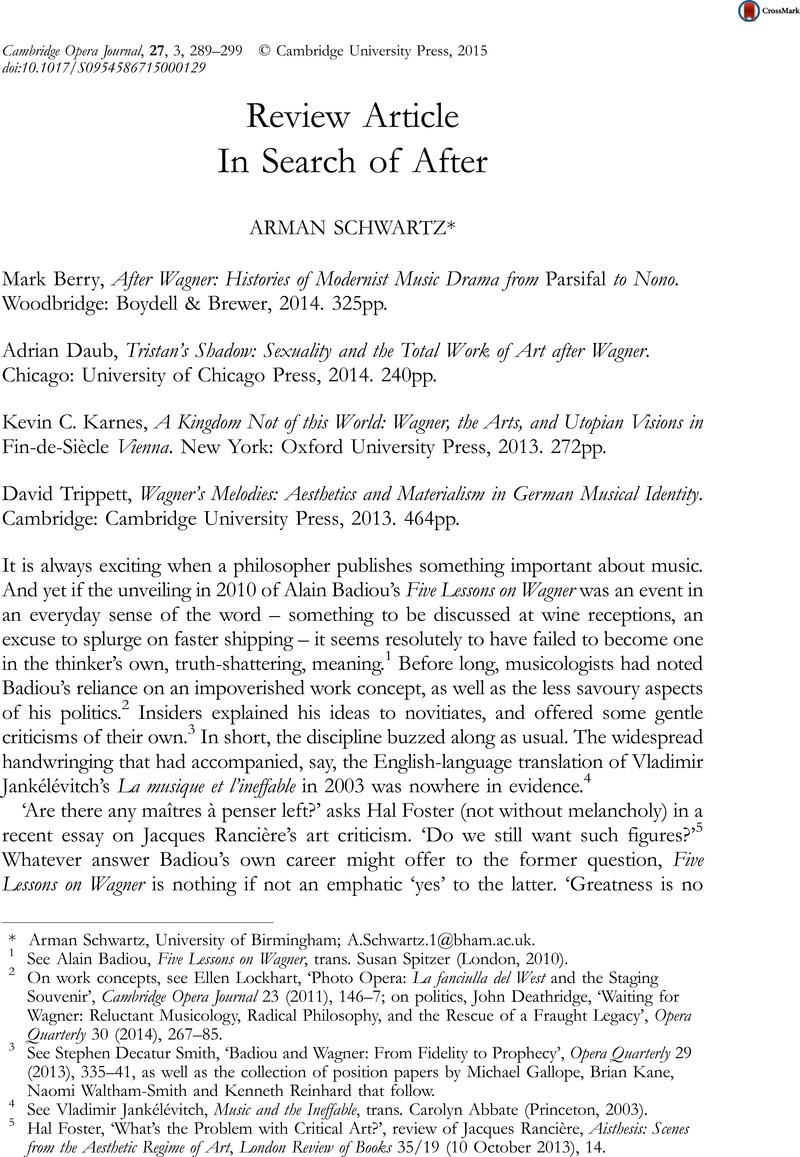No CrossRef data available.
Article contents
In Search of After
Review products
Published online by Cambridge University Press: 12 November 2015
Abstract

- Type
- Review Articles
- Information
- Copyright
- © Cambridge University Press 2015
Footnotes
Arman Schwartz, University of Birmingham; [email protected].
References
1 See Badiou, Alain, Five Lessons on Wagner, trans. Susan Spitzer (London, 2010)Google Scholar.
2 On work concepts, see Lockhart, Ellen, ‘Photo Opera: La fanciulla del West and the Staging Souvenir’, Cambridge Opera Journal 23 (2011), 146–147CrossRefGoogle Scholar; on politics, Deathridge, John, ‘Waiting for Wagner: Reluctant Musicology, Radical Philosophy, and the Rescue of a Fraught Legacy’, Opera Quarterly 30 (2014), 267–285CrossRefGoogle Scholar.
3 See Smith, Stephen Decatur, ‘Badiou and Wagner: From Fidelity to Prophecy’, Opera Quarterly 29 (2013), 335–341CrossRefGoogle Scholar, as well as the collection of position papers by Michael Gallope, Brian Kane, Naomi Waltham-Smith and Kenneth Reinhard that follow.
4 See Jankélévitch, Vladimir, Music and the Ineffable, trans. Carolyn Abbate (Princeton, 2003)Google Scholar.
5 Foster, Hal, ‘What’s the Problem with Critical Art?’, review of Jacques Rancière, Aisthesis: Scenes from the Aesthetic Regime of Art, London Review of Books 35/19 (10 October 2013), 14Google Scholar.
6 Badiou, , Five Lessons, 83Google Scholar.
7 Badiou, , Five Lessons, 82–83Google Scholar.
8 Badiou, , Five Lessons, 83Google Scholar.
9 Smith, Matthew Wilson, ‘A Note from the Guest Editor’, Opera Quarterly 30/2–3 (2014), 170Google Scholar.
10 Smith, ‘A Note’, 169.
11 See Smith, Matthew Wilson, The Total Work of Art: From Bayreuth to Cyberspace (New York, 2007)Google Scholar.
12 Smith, , Total Work of Art, 3Google Scholar.
13 ‘Is Strauss perpetrating all of the time what Wagner, advised by Cosima, might have been doing at the end of Die Meistersinger, deflecting attention away from devastation by engaging us in a paean to holy German art?’ (104).
14 See boulezian.blogspot.co.uk.
15 Bekker, Paul, The Changing Opera, trans. Arthur Mendel (London, 1935), 257Google Scholar.
16 It should also be said that Tristan’s Shadow suffers from remarkably poor copy editing. ‘Tragaldalbas’ and ‘Der geborgte Ehemann’ are given separate index entries. The claim, ‘As chapter 6 showed, operatic phantasmagoria depended on a particular operatic erotics’, surely refers to chapter 4 (‘Erotic Acoustics’) (190). Sentences at times seem to be missing words, leaving one to puzzle over proposals like, ‘But, in keeping with his divine attribute of fire, Loge is accurate messaging that can take place in signification (the subject of hermeneutics), but instead everything to do with the deception and distortion that can plague the signifying process’ (170).
17 See Davies, James Q., Romantic Anatomies of Performance (Berkeley, 2014)Google Scholar; and Dolan, Emily I., The Orchestral Revolution: Haydn and the Technologies of Timbre (Cambridge, 2013)CrossRefGoogle Scholar.
18 Paige, Kirsten, in Notes: Quarterly Journal of the Music Library Association 70 (2014), 708Google Scholar.


